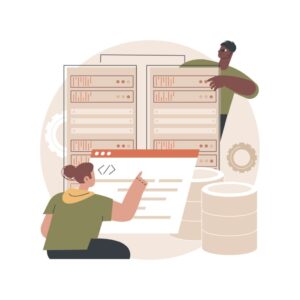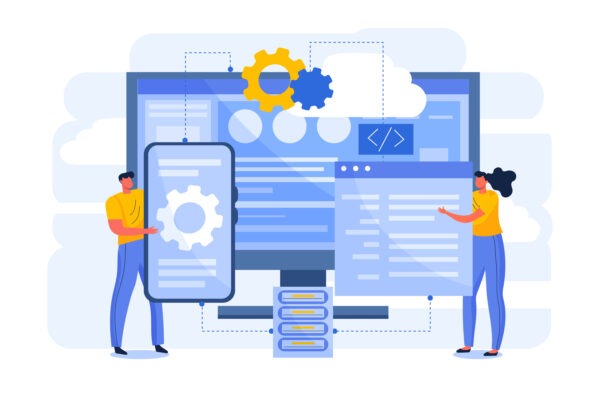Are you frequently frustrated by application performance issues? Are you finding it difficult to make changes to your application? Is your application frequently troubled by security issues? If you answered yes to any of these questions, it’s time to rethink your Ruby on Rails application’s architecture.
Here at Mallow, we’re big believers in the value of proper application architecture, and we continuously voice this. One of the key factors that keep our clients coming back to us is our thorough understanding of the needs, preferences, and behaviours of the users who will ultimately interact with the applications we architect. By delving deep into the requirements, we design and optimise the application in a way that truly resonates with their performance optimisation goals.
By following the recommendations outlined in the article, you will gain a comprehensive understanding of crucial factors that can potentially remove roadblocks in terms of application performance, scalability, and other challenges. The article delves into various aspects, such as optimising performance, ensuring scalability to handle increasing traffic, addressing potential bottlenecks, enhancing security, and maximising cost-effectiveness.
What are the steps involved in building the architecture of a Ruby on Rails application?
Step 1: Understand the functional and non-functional requirements
Functional Requirements
Functional requirements encompass the specific functionalities and features that the application must deliver to meet user requirements.
By addressing these requirements during the architectural design phase, developers can create a well-structured and efficient application.
- User authentication and authorisation
Identify user registration, and login requirements, to ensure proper user authentication within the application. For example, if your application carries Basic authentication, token-based authentication, SSO, OAuth, and Two-factor authentication, then you need to integrate the relevant services in relation to it.Considering authorisation, you can customise the user experience and ensure that each user has access to the appropriate features and actions based on their assigned role. For example, you may define roles such as “Admin,” “Manager,” and “User” within the application.
- Platform support
Different platforms, such as web browsers, mobile devices, or desktop applications, have varying capabilities, constraints, and user expectations. These factors influence the design choices made in terms of technologies, frameworks, and architectural patterns.For example, if the blog needs to be accessible on mobile browsers, the architecture may prioritise a responsive design approach, ensuring the blog adapts to different screen sizes and resolutions. This could involve the use of flexible layouts, media queries, and optimised image delivery to enhance the user experience on various devices.
- Integration
Identify any external systems or services that need to be integrated with the application, such as payment gateways, APIs, or third-party libraries. Plan the integration points and ensure smooth communication between the application and external dependencies. For example, let’s assume an application carries payment as a part of the workflow. Then, in this case, it requires integrating services like Stripe.
- Internationalisation and localisation
Design the application to support multiple languages and cultural conventions. Consider factors like language files, locale-specific formatting, and translation mechanisms to make the application accessible to a global audience. For example, in the case of a social media platform, the application might allow the users to switch to their local language.
- Specific requirements
Consider whether there are any specific/special requirements like real-time communications, advanced search, location-based requirements, event-tracking, notifications, etc. For example, if it is a chat application, you would need to communicate the messages in real-time, so considering them in the architecture stage would be essential. If the application demands to keep the client’s data independently, and securely then going with a multi-tenant approach is best suited.
Non-functional Requirements
The non-functional requirements focus on the quality attributes and constraints that govern the application’s behaviour. These include performance requirements, such as response time and scalability to handle a large number of concurrent users.
- Reliability
Ensure that the application is reliable and available for users. Consider factors like fault tolerance, error handling, exception management, and backup and recovery mechanisms to minimise downtime and provide a seamless user experience. For example, a mission-critical application used in the healthcare sector should have redundant systems and failover mechanisms to prevent service disruptions.
- Maintainability
Design the application with maintainability in mind, making it easier for developers to understand, modify, and extend the codebase. Consider factors like code modularity, separation of concerns, adherence to coding conventions, and documentation to facilitate future maintenance and updates.
- Extensibility
Architect the application in a way that allows for easy integration of new features and functionalities. Consider factors like modular design, loosely coupled components, and adherence to design patterns to enable seamless extensibility.
- Security
Ensure robust security measures to protect sensitive data and prevent unauthorised access. Consider authentication mechanisms, authorisation levels, and encryption techniques to ensure data confidentiality and integrity.

For example, using a CAPTCHA in your application will add an additional layer of security. It will prevent your application from brute-force attacks, spam and protection against sensitive data. Also, using Web Application Firewall (WAF) in front of your servers will give protection against DDoS attacks.
- Performance optimisation
Optimise the application’s performance by considering factors like database query optimisation, caching strategies, and efficient code implementation. Minimise unnecessary database hits, avoid N+1 queries, and utilise caching mechanisms for frequently accessed data.

For instance, an e-commerce website should load product pages quickly to provide a smooth shopping experience by adding proper database indexing and implementing caching to load data.
- Scalability
Design the application with scalability in mind to handle increased traffic and growing data volumes. Consider horizontal scaling options, asynchronous processing, and load-balancing techniques to ensure the application can handle increasing user demand.
For example, during Black Friday sales or year-end sales, e-commerce websites can expect high traffic. In this case, the application should be able to handle the traffic well enough and function without any interruptions.
- Compliance
Ensure the application adheres to relevant legal, regulatory, and industry-specific standards. Consider factors like data protection regulations (e.g., GDPR), accessibility guidelines (e.g., WCAG), and industry-specific compliance requirements (for example, HIPPA in the healthcare industry) to avoid legal issues and maintain trust.
For example, the application should comply with relevant legal and regulatory requirements, such as data protection laws or industry-specific standards. For instance, a financial application should adhere to financial regulations, ensuring the security and privacy of user financial information.
Step 2: Choose the most relevant architecture
Choosing the appropriate architectural style depends on various factors, including the complexity of the application, scalability requirements, development team structure, and deployment environment.
- Monolithic architecture is suitable for small to medium-sized applications with a relatively simple structure. It is characterised by a single, tightly coupled codebase where all components of the application are combined into a single deployable unit. This architecture is straightforward to develop and deploy but may pose challenges in terms of scalability and maintenance as the application grows.
- Client-server architecture is suitable for applications that require a clear separation between client-side and server-side responsibilities. It is commonly used in web-based applications where the client interacts with the server to request and retrieve data. This architecture enables centralised control and management of data and business logic.
- Microservice architecture is ideal when the application is large and complex and there is a need for independent scalability and rapid development of individual components. It allows for flexibility, and fault isolation and promotes modularity.
- Event-driven architecture is suitable when applications need to respond to and process events or messages asynchronously. It is commonly used in systems that handle real-time data processing, IoT applications, or systems that require loose coupling and high scalability.
- Serverless architecture is beneficial for applications with unpredictable or fluctuating workloads, as it abstracts away the underlying infrastructure and allows developers to focus solely on writing code. It is well-suited for event-driven and lightweight applications that require automatic scaling, cost optimisation, and minimal operational overhead.
Ultimately, the choice of architecture should align with the specific requirements and constraints of the application, ensuring that it optimally meets the functional and non-functional needs while considering factors such as scalability, development speed, maintainability, and resource efficiency.
Step 3: Choose the type of database
Choosing the right type of database is crucial for your application’s success. In traditional web applications, there is often a balance between read and write-heavy operations and the structure of the data is also defined. In such circumstances, a relational database management system (RDBMS) like PostgreSQL, MySQL, Oracle, SQL Server, etc, is preferred.
PostgreSQL is an open-source database that comes packed with a lot of additional plugins which could be used based on your application’s needs. Some of the famous plugins include PostGIS (geographic data), TimeScaleDB (time series data), ZomboDB (full-text search), etc. In the case of multi-tenant applications, PostgreSQL also allows you to create separate schemas for each tenant. This means that each tenant’s data is completely separate from the data of other tenants, and tenants cannot access each other’s data.

MySQL, on the other hand, is known for its ease of use, simplicity, and widespread adoption. It is often recommended for applications to prioritise speed and performance, particularly in read-heavy scenarios.
Plan the database schema, relationships, and data access patterns to optimise performance and data integrity. Consider factors like normalisation, indexing, and caching to ensure efficient data storage and retrieval.
For write-heavy applications, where there is a high volume of data being constantly inserted or updated, it is advisable to opt for a database that excels at handling write operations efficiently. In such cases, a NoSQL database like MongoDB, DynamoDB or Cassandra might be a suitable choice due to their ability to scale horizontally and handle large write workloads.
Step 4: Plan how to carry out file handling
When finalising your application’s architecture, planning your file-handling strategy is crucial to ensure efficient and secure operations. Consider whether your application is read-heavy or write-heavy, as this will impact the design and implementation of your file-handling system.
For read-heavy applications that focus on retrieving files, consider optimising read operations by implementing techniques like CDN or caching to improve performance.
On the other hand, write-heavy applications require efficient ways to handle file uploads, updates, processing, and storage. To manage write operations effectively, consider implementing file buffering, batching, or asynchronous processing.
If there is a specific requirement to maintain confidentiality, then protect sensitive files by employing encryption techniques. If there is a need to restrict file access to external users or restrict access based on user roles and permissions, you can use access control mechanisms. Implementing file integrity checks, such as checksums or digital signatures, can help ensure that files remain unaltered and maintain their integrity throughout their lifecycle.
Step 5: Implement caching
As you finalise your application’s architecture, including a plan for implementing caching to optimise performance and enhance user experience is important. Caching involves storing frequently accessed data in a temporary storage system, such as memory, to reduce the need for repetitive computations or database queries.
By strategically implementing caching mechanisms, you can significantly improve the responsiveness and scalability of your application. Consider factors like the nature of your data, the frequency of updates, and the expected traffic patterns to determine the appropriate caching strategies. Planning caching implementation early on will ensure a smoother and more efficient experience for your application’s users.
Step 6: Data transmission strategy
A well-designed messaging strategy ensures seamless data exchange, scalability, and fault tolerance. If your application involves real-time messaging and event-driven communication, technologies like message queues (e.g., RabbitMQ or Apache Kafka) or publish-subscribe systems (e.g., Web sockets, MQTT or Apache Pulsar) can be valuable choices.
Step 7: Finalise the infrastructure design
As you approach the finalisation of your application’s architecture, it is crucial to plan and design your application’s infrastructure to handle traffic efficiently and ensure optimal performance.
Consider the expected traffic patterns, scalability requirements, and user load to determine the appropriate infrastructure design. If your application anticipates variable traffic patterns, consider employing load-balancing techniques such as horizontal scaling and implementing a robust auto-scaling mechanism. Distribute the traffic across multiple servers or instances to prevent bottlenecks and accommodate increasing user demand.
Plan for fault tolerance by implementing redundancy and failover mechanisms to ensure high availability. Regularly monitor and analyse your application’s traffic patterns to make informed scaling decisions and optimise resource allocation.
How are the scalability and infrastructure of your application related to architecture?
The right architecture for a Ruby on Rails application solves several pain points. It addresses performance issues by optimising resource utilisation and implementing efficient algorithms. Scalability concerns are mitigated through the ability to handle increasing user loads and accommodate future growth.
It enhances security by implementing proper authentication and authorisation mechanisms and safeguarding against common vulnerabilities. With a well-designed architecture, unnecessary expenses are reduced through efficient resource utilisation.
The architecture of an application sets the foundation for its design, structure, and components, dictating how it functions and operates. When an application is architected with scalability in mind, it is designed to handle increasing workloads and growing user demands without sacrificing performance or stability.
Scalability, on the other hand, refers to an application’s ability to adapt and expand its resources to accommodate a larger volume of users or data. A well-designed architecture considers scalability a key factor, employing techniques like horizontal scaling, load balancing, caching, and distributed systems to ensure the application can handle increased traffic and workload.
Interested in knowing more about how to make sure your application is scalable? Once you have the right architecture, the next thing to ensure is that your application is able to scale with you. Check out our blog on ensuring the scalability of my Ruby on Rails application. This article will help you with just that.
Still not sure about what to do next? Feel free to get in touch with our team.
Your queries, our answers
No, Ruby on Rails is not a dying language. While newer frameworks have emerged, Ruby on Rails continues to be widely used, particularly for web applications that require rapid development and scalability. The community around Ruby on Rails remains active, and the framework is regularly updated with new features and security improvements. Check out here to know if Ruby on Rails is still relevant in 2025 and explore its current state and future prospects.
Mallow prioritizes security in every stage of development. We implement best practices like data encryption, secure authentication methods, and regular security audits. Ruby on Rails also has built-in security features, such as protection against SQL injection and cross-site scripting, which we utilize to safeguard your application.
The cost of building a Ruby on Rails application varies depending on the project's complexity, features, and scope. For a basic MVP, the cost ranges from $20,000 to $40,000 for a web app. For more complex applications, the cost can be significantly higher. We provide a detailed and transparent cost breakdown tailored to your specific requirements. Check out here to find out how much building a Ruby on Rails project with Mallow costs.
Yes, Mallow can integrate various third-party services, such as payment gateways, APIs, and external databases, into your Ruby on Rails application. Our team ensures seamless integration to enhance the functionality and user experience of your application.
Yes, we can align our working hours with your time zone to facilitate effective communication throughout the development process. Check out here to know how to handle the timezone difference.
Mallow offers the following outsourcing models: Project-based outsourcing, Staff augmentation, & Dedicated development team (DDT)
Ruby on Rails is a versatile framework that can be adapted to a wide range of projects. It excels in rapid development, making it suitable for startups, MVPs, and complex web applications. Whether you're building a large-scale e-commerce platform or a custom content management system, Ruby on Rails provides the flexibility and efficiency needed to support your project.
Mallow's development team is experienced in designing and implementing scalable Ruby on Rails applications. We use a combination of efficient code architecture, database optimization, and cloud infrastructure to ensure your application can scale to meet growing user demands without compromising performance.
The development timeline varies depending on the complexity and scope of the project. For a basic MVP, it might take around 3 to 6 months. More complex applications with advanced features could take longer. We work closely with you to establish a realistic timeline and keep you informed throughout the development process.
At Mallow, we emphasize thorough testing and quality assurance to ensure the reliability and performance of your Ruby on Rails application. Our QA team conducts various tests, including unit testing, integration testing, and end-to-end testing, to identify and fix issues before deployment.
No, we don’t provide off-the-shelf products. We are custom software solution providers who tailor applications in a customized way as you desire. However, we can create personalized applications tailored to your unique needs, providing you with a fully customized experience when using the application.
Yes, you can hire a dedicated Ruby on Rails developer or a team of developers from Mallow. This allows you to have a dedicated resource working exclusively on your project, providing more control and flexibility over the development process. Check out our article on the top 9 things to consider as you plan to hire a Ruby on Rails developer for more insights.
Author
Manivel
Manivel is the Chief Technology Officer (CTO) at Mallow Technologies, with over two decade of experience in the field of application development. His driving vision when co-founding Mallow was to empower businesses to unlock their potential through the strategic utilisation of technology. Over the years, he has solidified his reputation as a reliable technical partner and advisor to clients spanning various sectors. Manivel's unique proficiency in ideating and delivering customised application solutions has played a transformative role in facilitating the success of numerous enterprises amidst the ever-evolving digital landscape.



